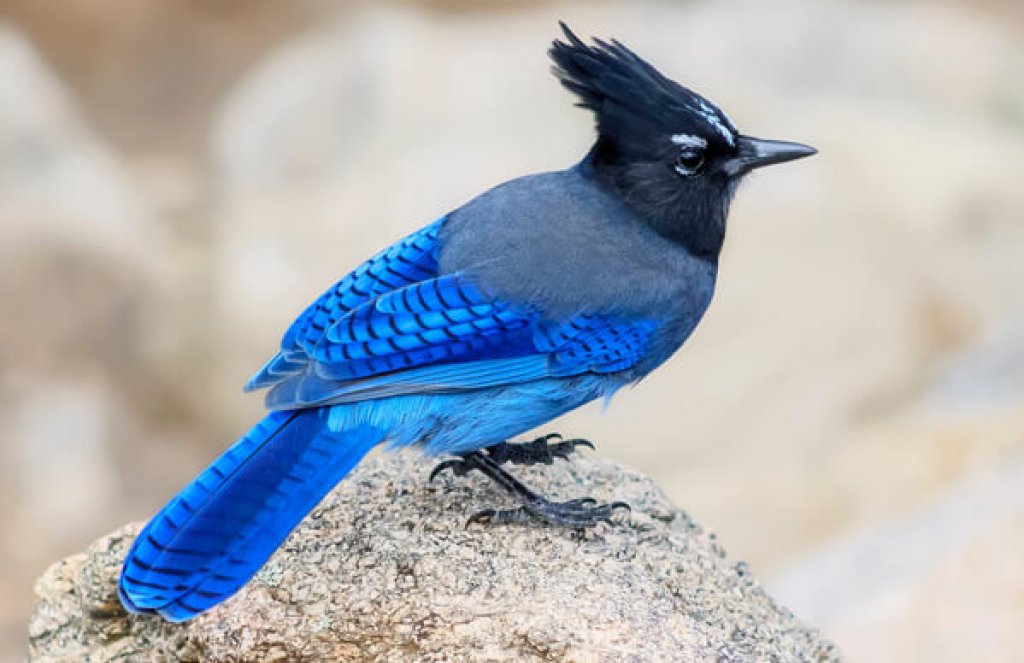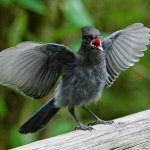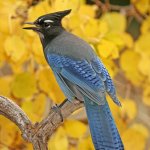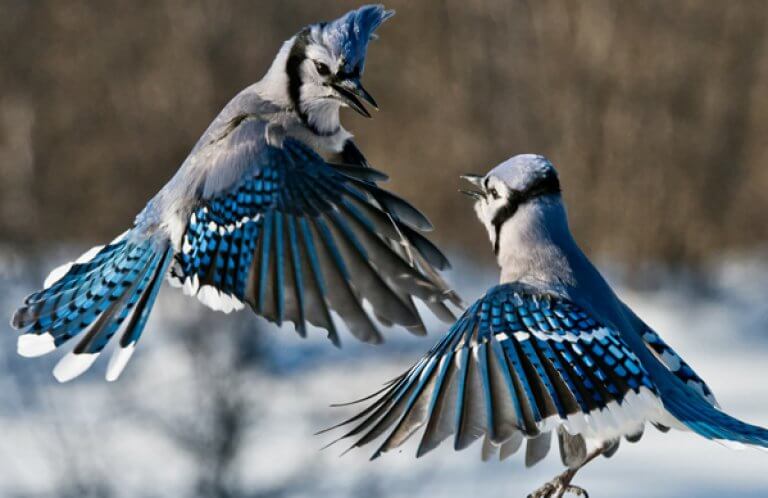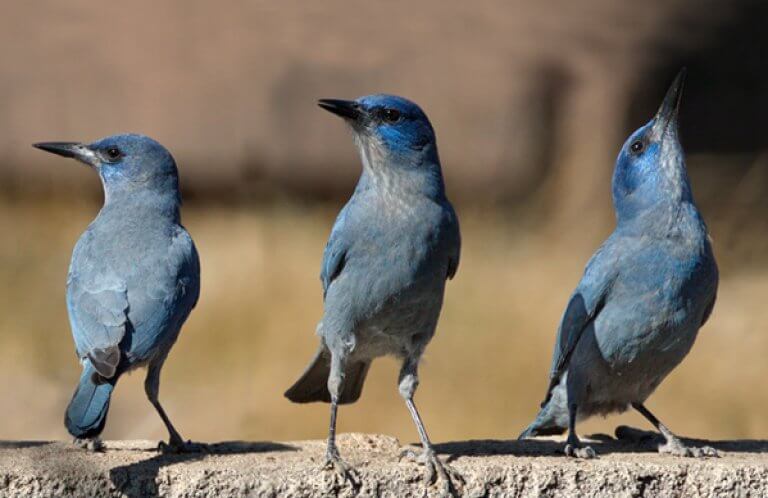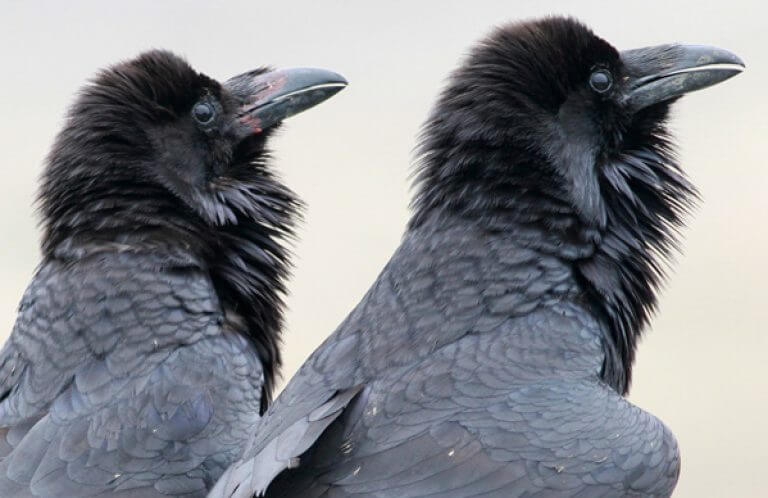About the Steller's Jay
The gregarious and noisy Steller's Jay traditionally has been the only crested jay found west of the Rocky Mountains, although in recent decades, its close relative the Blue Jay has made some inroads there. This robust species is also sometimes called long-crested jay, mountain jay, and pine jay, the latter two nicknames a nod to its preferred habitat of high-elevation coniferous forests.
A familiar sight at western campgrounds and picnic areas, this jay has subtly beautiful plumage of sooty black and rich blue shades that helps it blend into its shaded forest surroundings. Its wings and tail are blue barred with black, and it has a distinctive tall and shaggy black crest. Males and females look alike.
Although it's "stellar" in so many ways, this songbird has a name that's spelled differently.
Honoring a Stellar Naturalist
Although this handsome jay is a "stellar" sight, its species name stelleri actually honors a German naturalist and explorer, George W. Steller. Steller explored the Pacific Coast as a member of Vitus Bering's Arctic expedition of 1741, and is considered a trailblazer of Alaskan natural history. Steller collected and described this jay on a brief foray onto an Alaskan island.
During the same voyage, Steller described other animals that now bear his name. One of these, the Steller's Sea Cow, is now extinct; others, including the Steller's Eider (a sea duck related to the King Eider), Steller's Sea-Eagle, and Steller's Sea Lion, are in decline.
Songs and Sounds
Like other crows and jays, including the Pinyon Jay and Common Raven, the Steller's Jay is a highly vocal species equipped with a variety of loud calls. Although not quite as proficient a mimic as the Northern Mockingbird, the Steller's Jay is still an excellent imitator of other birds and animals, and even mechanical sounds such as those made by phones, sprinklers, and squeaky doors.
(Audio: Steller's Jay call by Frank Lambert, XC361830. Accessible at https://www.xeno-canto.org/361830. Steller's Jay group call by Allen Knue, XC456269. Accessible at https://www.xeno-canto.org/456269. Steller's Jay Red-tailed Hawk imitation by Thomas Magarian, XC603262. Accessible at https://www.xeno-canto.org/603262.)
Breeding and Feeding
Faithful Mates
These monogamous birds form long-term pair bonds and stay together year-round. Steller's Jays typically nest in the shelter of a dense conifer, where both members of the pair build a bulky nest of twigs, weeds, moss, and leaves, held together with mud and lined with softer materials such as rootlets and pine needles. The Steller's Jay and the Blue Jay are the only New World jays that use mud in nest construction.
These noisy birds become surprisingly quiet during their nesting season, slipping silently through the trees as they attend their nests and young.

The male feeds the female while she incubates her four to five eggs. Both members of the pair feed the young, which leave the nest after a few weeks. The adults continue to feed the young birds for about a month after they fledge.
So Many Subspecies
This jay is highly variable, with 16 to 17 subspecies that are separated by crest color and length, the amount of black on the head, the color and extent of streaks on the forehead and light markings around the eye, throat color, and body size.
Consummate Omnivores
Steller's Jays are omnivores, eating seeds, nuts, berries, fruit, invertebrates, bird nestlings and eggs, and small rodents. They sometimes even prey on adults of smaller species such as the Dark-eyed Junco or Pygmy Nuthatch. They are quick to take advantage of human food sources, including bird feeders and garbage bins at picnic areas and campgrounds. In areas where federally Threatened Marbled Murrelets breed near campgrounds, Steller's Jays have been documented not only snapping up leftovers, but also the scarce seabird's eggs and nestlings.
Like other members of the crow and jay family, Steller's Jays cache supplies of food, particularly acorns and pine seeds, for recovery during lean times. They relocate their own caches using excellent spatial memory and also plunder stores made by other birds such as Acorn Woodpeckers.
Region and Range

The Steller's Jay can be found in coniferous and mixed mountain forests of western North America, from southern Alaska south and east to the foothills of the Rocky Mountains, where it occasionally hybridizes with the Blue Jay. It is also found in Mexican highlands, south into Central America as far as northern Nicaragua.
Conservation of the Steller's Jay
Unlike many other birds, the Steller's Jay seems to thrive in human-altered habitats. The species is still common, but it's vulnerable to many of the same factors threatening less adaptable species, particularly predation by cats, pesticide poisoning, and collisions. Fortunately, ABC has a number of programs in place to tackle these threats, including our Cats Indoors program, which encourages pet owners to keep cats and birds safe, and our Glass Collisions program, which offers solutions to birds hitting windows.
Get Involved
Many of the rarest bird species in the Western Hemisphere remain relatively unknown. You can learn more about these birds and the threats they face by signing up for ABC's Bird of the Week email series, which frequently highlights these fascinating birds.
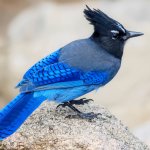
Help support ABC's conservation mission!
American Bird Conservancy and our partners throughout Latin America and the Caribbean have created and expanded more than 100 bird reserves, which protect upward of 1.1 million acres of vital habitat. Together, we've planted more than 6.8 million trees, helping to restore degraded and damaged habitat. You can help us continue to protect endangered birds by making a gift today.





































